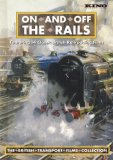| Reviews & Columns |
|
Reviews DVD TV on DVD Blu-ray 4K UHD International DVDs In Theaters Reviews by Studio Video Games Features Collector Series DVDs Easter Egg Database Interviews DVD Talk Radio Feature Articles Columns Anime Talk DVD Savant Horror DVDs The M.O.D. Squad Art House HD Talk Silent DVD
|
DVD Talk Forum |
|
|
| Resources |
|
DVD Price Search Customer Service #'s RCE Info Links |
|
Columns
|
|
|
On and off the Rails: The British Transport Films Collection
Kino International has released one of my favorite DVD collections this year, On and Off the Rails: The British Transport Films Collection, a gathering of 14 classic British railroading films produced between 1951 and 1980. Growing up right next to a busy rural train terminal, I suspect the power and majesty of huge trains in motion was a key influence on my formative years, which makes On and Off the Rails: The British Transport Films Collection such a treat for me. But you don't have to be a rail enthusiast to enjoy this spectacular collection; anyone interested in the British documentary movement will find hidden little gems here that will delight.
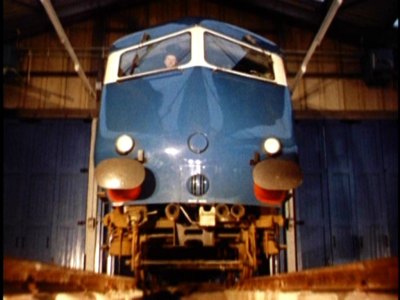
In 1948, Britain's Labour government nationalized the country's railways, and the resulting British Transport Commission set up an in-house documentary film unit whose mission was to extol the virtues of British rail travel, inform the public how British rail was propelling the country forward into prosperity (after the deprivations of the Second World War), while providing internal industrial training films for rail personnel. Led by John Grierson pupil Edgar Anstey (1935's Housing Problems), British Transport Films soon made shorts not only for the BTC, but also London Transport, the Inland Waterways Board, and the British Railways Board (the organization that replaced the BTC in 1963). Hundreds of titles were produced under Anstey's tenure (he stayed in his position until 1974), with the unit continuing under John W. Shepherd until it folded in 1982.
At first glance, On and Off the Rails: The British Transport Films Collection may seem like just a bunch of train documentaries. However, on closer inspection, it's a surprisingly rich, layered look at post-WWII British society, its dreams, how it viewed itself moving forward into the 20th century, how it valued its cultural legacy, and how it dealt with a rapidly vanishing way of life. While all of the films included in the On and Off the Rails: The British Transport Films Collection were produced with the primary purpose of convincing the British people that rail travel was the ideal method of transportation, such a potentially dry mandate is successfully elevated by artistic meditations on a variety of subjects, including the common worker and his place in society, the average housewife who yearns for something more out of her busy domestic lifestyle, the harried yet dedicated bureaucrat working alongside the tradesmen, tirelessly keeping the trains running, and most poignantly, the well-being and personal enjoyment that comes - as well as the inevitable passing of one way of life for another - when progress, both social and technological, is achieved.
Evidently, there are British critics of these documentaries who derisively charge them with "romanticism" and "commercialism" - two detested strains of the British documentary movement that enrage social realists who demand absolute fidelity to exposing social ills (along with a rather dour, pessimistic outlook on achieving those problems' solutions). Anything that smacks of celebrating British good-will and prosperity post-WWII is considered at best romantic fantasy, and at worst, an outright lie. However, it's hard to rationalize away the fact that the majority of the British documentary movement was largely financed by private and government industry (there goes your commercialism charge). As for "romanticism," that aspect of documentary filmmaking should only bother you if you truly believe that documentaries are effective tools of social change (debatable). And even given that, an argument can be made that adding such public-pleasing elements to documentaries, such as recreations, staged events, and scripted sequences, makes the subject matter more accessible to average filmgoers. Either way, I can't see how such dramatic conventions, or a discernable nostalgia infusing many of the films here in On and Off the Rails: The British Transport Films Collection, should be seen as drawbacks to enjoying them. And as strict photographic records, the films of On and Off the Rails: The British Transport Films Collection are invaluable looks at how people dressed, how they traveled, and what their neighborhoods and countrysides looked like during the 1950s through the 1970s.
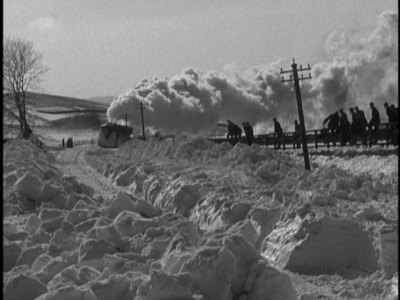
DISC ONE:
Blue Pullman (1960)
Directed and Written by James Ritchie. Edited by Hugh Raggett. Cinematography by David Watkin and Jack West. Color. 23 minutes.
The experts at the British Transport Commission test a new luxury express line: the Blue Pullman.
Shot in gorgeous color, Blue Pullman celebrates not only the coming luxury that Britons wished were everyone's right, but also elevates the technicians and craftsmen who work tirelessly to bring the utmost in technology (and luxuries) to the average British rail traveler. There are some particularly spectacular shots of the bright blue Pullmans powering through the beautiful English countryside. A telling shot shows the high-powered diesel passing an old-fashioned steam engine, while the noble, stirring soundtracks wells up on the speakers. Of course, the supreme irony of Blue Pullman is that the line never really took off - there were not enough customers interested in its expensive service.
Elizabethan Express (1954)
Directed by Tony Thompson. Edited by William J. MacLean. Cinematography by James Ritchie, Ronald Craigen, Robert Paynter. Written by Paul le Saux. B & W. 20 minutes.
The high-speed, non-stop express from King's Cross Station to Waverley Station in Edinburgh, Scotland is looked at here, with the viewer getting a detailed view of the craftsmen and workers who actually fashioned the train, to the station workers and communication technicians who fit in the special summer express runs for tourists.
Shot in velvety black and white, with the marvelous rhyming verse of Le Saux, Elizabethan Express is a stirring document of a seemingly innocuous event: a six-and-a-half hour train ride through the English countryside. I love the term, "chasing seconds," as the engineers try to figure out how they can push the train to make up for lost time due to delays. Languid, beautiful film.
Train Time (1952)
Directed by John Shearman. Edited by Stewat McAllister. Cinematography by Ronald Craigen. Written by John Rowdon. B & W. 28 minutes.
The demand for extra railway cars for broccoli farmers in West Cornwall throws the intricately plotted scheduling of the entire South Wales train time table.
Detailed look at the seemingly impossible task of rerouting and allocating available train cars all over the country, to meet the demands of industry and travelers. This doc feels more like a short, scripted fiction film, but the actors (if they indeed are actors - they certainly seem like the real articles) convey the tense demand for constant alterations to the schedule quite well. Beautiful, lyrical passages in the script ("These are the small hours, when it is neither today or tomorrow") over evocative night-time shots of various cities.
Rail 150 (1975)
No credits given. Color. 13 minutes.
Shildon's Grand Steam Cavalcade on August 31, 1975, is featured, celebrating the 150th anniversary of the first public passenger steam railway.
A engine lover's dream doc, with endless shots of vintage engines that are world famous, including the "Flying Scotsman," "Princess Elizabeth," "Raveningham Hall," and the "Evening Star." Visually not impressive; still, it's amazing to see these vintage machines in perfect working condition.
The Diesel Train Driver (1959)
No credits given. B & W. 7 minutes.
The public is introduced to the new diesel engines used on the main lines.
Actually the first part of a four-part series, this first section (An Introduction to the Diesel Train) attempts to instruct the public about the benefits of British rail's switch to diesel engines on all main lines (steam engines were retired from the main lines the year before). While it's cool to see that new forward look, unfortunately, those new diesels made train travel seem more and more like traveling on a bus - with the simplified instrumentation and the driver fully visible furthering that mundane feeling. Canny use of the old driver to assure passengers of old-time experience, with the new trainee who represents the future of rail travel. Super-sharp lensing.
On Track for the Eighties (1980)
Directed and Edited by John Legard. Written by Glyn Jones. Color. 12 minutes.
An industrial report on the state of British rail.
The new "Age of the Train" is declared - no doubt due to the worldwide oil crisis at the time. Efforts at modernization and technical innovations are detailed, including the electrification of many old diesel lines. No nostalgia here for the old days; the lyricism of the older BTF films is gone for this straight-ahead report.
Cybernetica (1972)
Directed by Peter Sims. Edited by John Legard. Cinematography by Trevor Roe and Merlyn Davies. Written by James Ritchie. Color. 19 minutes.
Three young women travel by rail and other methods of transportation to Paris.
The benefits of computerization are explored in this celebration of the independent young women who increasingly rode the rails. The benefits of technical innovations are directly linked to the increasing emancipation of women in this decidedly "mod" doc.
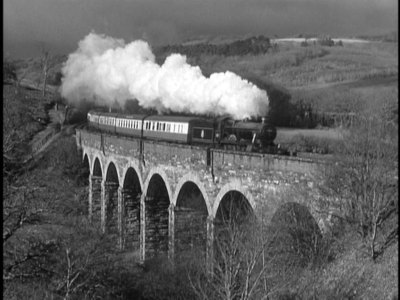
DISC TWO:
Under the River (1959)
Directed and Written by R. K. Neilson Baxter. Edited by Cynthia Barkley and Terry Trench. Cinematography by David Watkin, Ron Bicker and Trevor Roe. B & W. 21 minutes. The world famous Severn Tunnel - still the world's longest underwater tunnel in 1959 - is looked at, with an historical overview of its engineer, Thomas Andrew Walker, and a look at the mechanics of the massive pumps used to keep it clear of water.
What starts off as a simple yet instructive history lesson soon turns elegiac when we learn that the beautiful Cornish steam pumps that keep the tunnel dry are soon to be replaced by modern, more efficient electric pumps. Without being maudlin, it effectively gets across the feeling that technology is changing a way of life in England.
Snowdrift at Bleath Gill (1955)
Directed by Kenneth Fairburn. Edited by John Legard. Cinematography by Robert Paynter. Written by Paul le Saux. B & W. 10 minutes.
In the snowy Westmorland Hills, a freight train becomes stuck in a massive snow drift. Snow plow engines only do part of the trick; it's up to the hand labor of the diggers to get the train out.
One of the most beautiful films in this collection, with an amazing editing scheme that elevates the incredibly arduous labor of the diggers to something akin to ballet. The next time you hear a friend complaining about how hard their job is, show them this film. Watch some of these old timers out in frigid 40mph winds, with no gloves, cutting huge slabs of icy snow and muscling it out of the way of the tracks. Equally amazing is the way they thawed out the frozen parts of the train: by taking cotton wadding, soaked in paraffin, wrapping them around the frozen parts, and setting them on fire! Spectacular shots of the train plow lifting up sheets of snow, as well as beautiful chiaroscuro silhouettes of the dark-clad workers in the white snow. One of the most beautiful documentaries I've ever seen.
This Year - London (1951)
No credits given. B & W. 24 minutes.
The annual outing for a shoe factory is facilitated by a special express train to London.
Beautifully observant, heartfelt documentary, told in a simple, direct style. Probably the best short in this collection for seeing what life in England looked like in 1951: how people dressed, what the streets of London looked like, what cars where on the streets. The framework of having a journalist go along to record this seemingly mundane outing allows the lyrical narration to be integrated nicely. Watching these workers (who certainly seem real) coming to the big city to enjoy tea at Hampton Court, a cruise on the Thames, a bus coach tour of all the city's monuments, and an evening of theatre and the movies in the busy West-End, perfectly captures the rhythm of a busy day gradually winding down, getting across to the viewer that wonderful feeling of having a day to truly remember. The simple, loving way in which the workers are celebrated in this film brought a lump to my throat. A masterpiece.
This is York (1953)
Directed by J. B. Holmes. Edited by Margot Fleischner. Cinematography by Ronald M. Craigen. Written by Paul le Saux. B & W. 20 minutes.
The station manager of York Station shows us a typical day at this vitally important juncture.
Another beautifully realized look at the intricate workings of railway station and main line. Good detail on what exactly is involved in keeping the trains running on time. Good framework using the station manager guiding us through a typical day, with a marvelous final shot of the sun setting on York.
The Great Highway (1966)
Directed and Edited by R. K. Neilson Baxter. Cinematography by Ron Bicker, Trevor Roe, and Jack West. Written by Kay Mander. Color. 20 minutes.
George Stephenson and subsequent engineers' work evolve into the main lines of London, Manchester, Liverpool and Crewe. And there purpose has always been to serve the public. Therefore, the new electrification of the main lines would be a welcome innovation by those pioneers.
A nicely paced history lesson that seeks to bridge the gap between the nostalgia of the old main line steam engines, and the necessity for modern innovations such as electrification. Not as lyrical as the earlier black and white efforts, but notable for advancing the notion (which is debatable) that the long-ago pioneers of industry would be the first ones to advance the dismantling and improvement of their original designs, in the name of advancing technology.
A Day of One's Own (1956)
Directed by Kenneth Fairbairn. Edited by Margot Fleischner. Cinematography by Robert Paynter. Written by Paul le Saux and Kenneth Fairburn. B & W. 20 minutes.
Woman across England, Scotland and Wales leave behind their routines to travel by rail to rediscover and renew their spirits.
Although some modern critics may sneer at the women returning refreshed to their domestic duties, A Day of One's Own is rather forward-looking in its treatment of women's roles in England, and the gradually increasing personal searches many of them undertook to find deeper meaning in their restrictive lives. And if you're not interested in proto-feminist politics, there's a fashion show included for you, ladies!
John Betjeman Goes By Train (1962)
No credits given. B & W. 10 minutes.
Writer and historian John Betjeman takes us on a journey from King's Lynn station, to Wolferton in Sandringham, to Snettisham, and finally Hunstanton.
Betjeman, an engaging host, confidently takes us on an architectural tour and tells us why these stations matter to him - and why they should matter to us. Marvelous to see the famous Wolferton station (according to Betjeman, unlike any other one in England), which now, unfortunately, is a private residence and closed to the public. Betjeman had many critics who jeered his love of nostalgia, but that's precisely why I do enjoy him. A moving little short, beautifully written (one assumes) by Betjeman.
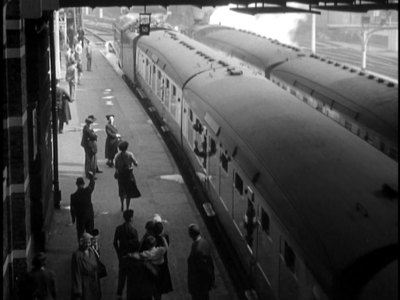
The DVD:
The Video:
Of course, all the documentaries presented here are in their correct full screen, 1.33:1 ratios. And except for some normal wear and tear on the prints, the transfers for the films in On and Off the Rails: The British Transport Films Collection look remarkably clean and clear. I saw no compression issues, either.
The Audio:
The English mono audio tracks represents the original theatrical presentations. No subtitles or close-captioning are available.
The Extras:
Unfortunately, there are no extras. Even a short text history of the BTF unit, to put the films here in some kind of context, would have been welcome.
Final Thoughts:
I understand that five other volumes of these British Transport Films documentaries have been released in Region 2, so let's hope On and Off the Rails: The British Transport Films Collection will be the first of several more releases of these fascinating, beautiful short films. They're not just documentaries about trains; they provide a tantalizing, layered look at how Britain viewed itself from the early 1950s to the late 1970s. Even though Kino International failed to provide any extras, the uniqueness of this collection, and the absolutely first-rate presentation, warrants the highest rating we have here at DVDTalk: the DVDTalk Collector Series.
Paul Mavis is an internationally published film and television historian, a member of the Online Film Critics Society, and the author of The Espionage Filmography.


|
| Popular Reviews |
| Sponsored Links |
|
|
| Sponsored Links |
|
|
| Release List | Reviews | Shop | Newsletter | Forum | DVD Giveaways | Blu-Ray | Advertise |
|
Copyright 2024 DVDTalk.com All Rights Reserved. Legal Info, Privacy Policy, Terms of Use,
Manage Preferences,
Your Privacy Choices | |||||||









